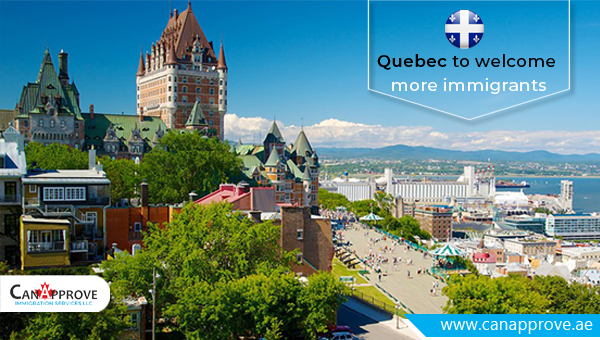The private sector in Canada reported a record rate of job vacancies in the first three months of 2019. Among the provinces, the highest number of job vacancies in Canada was reported in Quebec, says a news update by the Canadian Federation of Independent Business (CFIB). The update further reveals that a total of 435,000 job vacancies in Canada were reported in the first four months of 2019, which has put the job vacancy rate in the country at 3.3.percent.
Ted Mallet, vice-president and chief economist of the CFIB was quoted as saying by the CIC News that Canada job vacancy rate had been climbing steadily in the past two years and reached a record high last quarter. The update from CFIB also observes that the labour shortages affected skilled positions more, compared to semi and unskilled occupations. The labour shortages are also putting pressure on employers to increase wage levels.

Despite the fact that Canada job vacancy rate is coming down compared to the same period in 2018, labour shortages continue to be a challenge, especially in Quebec, British Columbia and Ontario. Quebec witnessed the highest level of labour shortage with the job vacancy rate reaching 4.1 per cent in the first quarter of 2019. The second-highest job vacancy rate was reported by British Columbia at 3.6 per cent. Ontario came third with 3.3 per cent.
Canada job vacancy rate: Province-wide data
The construction sector was the industry sector that faced the highest job vacancy rate in the first quarter of 2019 at 4.9 per cent. The personal services sector reported the second-highest job vacancy rate at 4.7 per cent. The agricultural business sector came third with a job vacancy rate of 3.8 per cent, followed by the hospitality sector at 3.7 per cent.
The number of job vacancies can also be interpreted as a high rate of job creation in Canada that continues to defy expectations. A record 106500 news jobs were created in April followed by another 27700 in May. Unemployment in Canada was also at its lowest point in more than 40 years. This situation has also benefited the new immigrants in the age group of 25-54, as the employment rate among them rose to 71 per cent in 2018.
For eligible migrants, especially skilled workers with qualifications and experience, Canada is a land of countless opportunities. Do you think you have the right set of skills and experience to make it big in Canada? Then there is no better time than now to migrate to Canada. CanApprove, with more than two decades of experience in migration, is ready to offer you any advice or assistance in this regard! Contact us for further details.
Data released by the Australian Department of Home Affairs show that the processing time of applications for Australian citizenship came down by 10 percent in 2019. The number of citizenship applications approved by Australia has also increased during the current year, according to data. To be precise, the number of Australian citizenships granted doubled during the period between 1st July 2018 and 30th April 2019, compared to the same time period in the previous year.
Drop in the processing time of Australian citizenship applications mean that 75% of applications will be processed within 18 months as opposed to 20 months. By processing time, we mean the period between the time when the citizenship application is submitted to the time of conferring the citizenship. The Department of Home Affairs observes that the reduction in waiting time is mainly owing to the reforms implemented by the Australia government to streamline the application process for Australian citizenship. By introducing these reforms, the Department of Home Affairs aimed to streamline the application process without compromising on national security or integrity of the process.

Currently, 220,000 applications for Australian citizenship are pending for approval. This number is lower compared to the same point of time last year, when the number of pending applications was 250000. The number of applications came down mainly owing to the reduction in the processing time. The Department expects that this number will come down further in the coming years. For 90 per cent of applications though, the processing time remains unchanged at 23 months.
Applying for Australian Immigration through PR programs is the way of moving towards Australian citizenship. Moving to Australia permanently has a lot of benefits that include high quality of living and vast opportunities for career growth. Besides, Australia offers high quality education and world class healthcare.
No wonder that people from across the globe want to make Australia their permanent home. Do you think it’s time for you too to take the big step? Then why hesitate? Contact us to know what you need to do in order to migrate to Australia.
In the latest Express Entry draw held on June 12, the Immigration, Refugees and Citizenship Canada(IRCC) issued 3350 Invitations to Apply(ITAs) for permanent residence in Canada. The Comprehensive Ranking System (CRS) cut-off threshold for the latest draw was 465, five points lower than the score required in the previous draw. The CRS cut-off threshold for the draw held on May 29 was 470.
As in the previous draws, tie-break rule was applied in the latest draw too, the time stamp given being June 6, 2019 at 13:51:59 UTC. It means not all candidates with a CRS score of above 465 received invitations. Priority was given to those candidates who submitted their profiles before the said date and time.
This is the 12th Express Entry draw to be held in 2019 and the 119th since the Express Entry system came into existence in 2015. With 38,450 invitations issued so far, it appears that 2019 will be yet another great year as far as Express Entry is concerned. The number is 6,250 more than the total number of ITAs issued during the same period of time in 2018, the year which saw a record 89,800 ITAs being issued. Canada has set an even higher target for 2019 and it means the CRS cut-off threshold is likely to come down in the upcoming draws.
The Government of Canada aims to process applications for permanent residence from Express Entry candidates within six months or less.
Minimum CRS requirements in the Express Entry draws held this year:
Interested in Canada immigration through Express Entry? Contact us for more information and guidance.
The number of new immigrants finding jobs in Canada soon after they arrive in the country reached a new high in 2018, according to an internal memo of the federal government. The memo observes that the Express Entry system and strong job creation are the major factors that led to this increase. Canada has been welcoming more economic immigrants with in-demand skills and experience in recent years. Unemployment was at its lowest level in more than 40 years in the country. All these developments have also contributed to the increased placement of new immigrants.
The memo further says that the employment rate of immigrants in the 25-54 age group, who came to Canada in the last five years, is 71 per cent. This is the highest rate since the employment rate of immigrants began to be recorded in 2006. Immigrants in the age group of 25 to 54 were found to be well educated and 80 per cent of them possessed post-secondary level education in 2018, compared to 75 per cent in 2008. The percentage of Canada’s general population with post-secondary-level education, in the same age bracket, was 71 per cent during this period. These figures have a huge significance at a time when Canada is all set to increase the number of immigrants the country welcomes each year to well beyond 300000.

The memo also revealed that among the second-generation Canadians, 95 per cent of 25 to 44-year-olds have completed high school. But the percentage among those with two Canadian-born parents was 89 per cent. The percentage of university degree holders among second-generation Canadians was 41 per cent, while the percentage of those with Canadian-born parents was 24 percentage. The average income of second-generation Canadians was also found to be high at $55,500, nearly $4,000 higher than those with Canadian-born parents.
According to data from Statistics Canada, the total number of newcomers in Canada in the year 2018 was 321,065. This is the highest number ever since 401,000 new immigrants came to Canada in 1913. As Canada has set a target of welcoming more than one million immigrants by 2021, these numbers are set to rise further. Canada will be welcoming 330,800 newcomers in 2019, a total of 341,000 in newcomers in 2020 and 350,000 newcomers in 2021.
With Canada set to welcome more skilled immigrants to the country, there is no better time than now to migrate to Canada. CanApprove, with more than two decades of experience, has helped thousands of our clients to successfully migrate to Canada. Contact us for any advice or assistance for Canada migration.
The Quebec government introduced a few important proposals related to immigration on June 7, which are likely to lead to the Quebec immigration levels touching 52,500 in 2022. This translates into an increase of 10,500 newcomers compared to a maximum of 42,000 newcomers this year. If the new proposals are any indication, Quebec is returning to the immigration levels that existed before the new Coalition Avenir Québec (CAQ) government came to power in October 2018. These proposals are also expected to be the basis of public hearings on immigration, which will begin on August 12.
Changes in Quebec immigration levels
The Quebec immigration levels were above 50000 during the period between 2015 and 2018. In the late 2018, the government of Quebec decided to bring down the immigration levels as part of fulfilling an election promise that the concerns regarding the newcomers failing to properly integrate into the Quebec community would be addressed.

In the proposals introduced on June 7, the Immigration Ministry of Quebec (MIDI) explained that the number of newcomers was reduced last year with an aim to revamp the integration programs and services of the province. Now the government will gradually increase the number of newcomers per year by 3000 or 4000 between 2020 and 2022. It will allow both state and civil society actors to provide immigrants with the tools they need to successfully integrate into Quebec society. So, by 2022, the immigration levels will be between 49,500 and 52,500. Out of these, 65 percent of newcomers will be selected through the economic-class immigration programs of Quebec.
The other major proposals include:
- Favour foreign workers and foreign nationals with a degree in Québec, who meet the province’s labour market needs and are already living in Quebec
- Favour skilled applicants with in-demand training or a validated job offer
- Expedite the arrival of economic-class immigrants
- Support employers in their efforts to recruit temporary foreign workers
- Promote the selection of immigrants who know Quebec’s values
- Expand the number of adult immigrants who speak French
- Encourage permanent immigration of young people
Migrating to Quebec guarantees vast opportunities for career growth and high standards of living. CanApprove is a recognized immigration consultancy with decades of experience in Canada/Quebec migration. Contact us for any advice or assistance with regard to Quebec migration.
Manitoba Provincial Nominee Program (MPNP) issued 209 invitations to apply for provincial nomination in the latest draw held on June 7. The invited candidates belonged to the Skilled Workers in Manitoba, Skilled Workers Overseas and International Education streams of MPNP.
Out of the total invitations issued, 121 Letters of Advice to Apply (LAAs) were issued to Skilled Workers in Manitoba candidates, with a minimum score of 542. Skilled Worker Overseas candidates received 60 LAAs and their minimum required score was 701. The remaining 28 LAAs were issued to International Education Stream candidates. The candidates who have received the LAAs can submit a complete application for provincial nomination with all the supporting documents within 60 days.

Manitoba immigration
Manitoba is one of the most popular destinations for Canada immigrants to settle in. Last year, the province issued nominations a total of 5,207 candidates, which is a record. Under the Skilled Workers in Manitoba stream of the MPNP, temporary foreign workers and international student graduates currently working in Manitoba can apply for provincial nomination. The candidates must also have a permanent, full-time job offer from a Manitoba employer.
The Skilled Workers Overseas stream allows Manitoba to nominate eligible candidates living outside Canada and having an established connection to the province, in the form of previous education or work experience or close relatives or friends living in the province. An invitation under the Strategic Recruitment Initiatives of MPNP also makes them eligible for provincial nomination.
Manitoba Expression of Interest
In order to be considered for provincial nomination from Manitoba, the candidates must first submit an Expression of Interest to the MPNP. Based on the information provided on basic eligibility factors in the Expression of Interest, each candidate is awarded a score and the highest scoring candidates are invited to apply for provincial nomination. The Express Entry candidates who receive provincial nomination from Manitoba will obtain 600 additional Comprehensive Ranking System (CRS) score points that guarantee an invitation to apply for permanent residence in Canada in the subsequent Express Entry draw.
Canada provincial nominee programs are a viable option for those who wish to migrate to Canada. Choosing the right pathway is very important in deciding the success of your application for Canada migration. CanApprove, with years of experience in Canada migration can help you make the right choice! Contact us for any advice or assistance with regard to Canada migration.
The latest Saskatchewan Immigrant Nominee Program (SINP) draw held on June 6 invited Express Entry and Occupation In-Demand candidates. The draw issued to a total of 426 invitations out of which, 342 invitations were issued to candidates belonging to the Occupation In-Demand sub-category and the remaining 84 went to Express Entry candidates.
The cut-off score for the candidates of both the sub-categories was 75. This is 7 point less than the cut-off score of the previous SINP draw held on May 15. With the latest draw, the total number of invitations issued to Saskatchewan Express Entry candidates this year has reached 898, and to Occupation In-Demand candidates has touched 1196.
Saskatchewan Express Entry sub-category:
The Saskatchewan Express Entry sub-category is aligned to the federal Express Entry system. The Express Entry candidates who receive provincial nomination from Saskatchewan would obtain 600 additional Comprehensive Ranking System (CRS) score points, which would ensure them an invitation to apply for permanent residence in Canada in the subsequent Express Entry draw.
In order to be eligible to apply for provincial nomination under the Saskatchewan Express Entry sub-category as well as the Occupations-in-demand sub-category, the candidate must have work experience in one of the 19 occupations in the in-demand occupations list of Saskatchewan.
The candidates who wish to be considered for provincial nomination under the Saskatchewan Express Entry sub-category must first submit an Expression of Interest (EoI) with the SINP. The EoI must include important details such as the candidate’s education, work experience and language proficiency, among the information about other eligibility factors. Each selected candidate will be awarded a score out of 100 and the highest-scoring candidates will be invited to apply for a provincial nomination from Saskatchewan.
Canada PNP is a great option for those who are less fortunate with Express Entry. Contact us if you want to know which Canada migration pathway is the best for you!
The Canada Government has launched a new initiative that will make it easier for newcomer women to find a job in the country. Under the initiative, these women will be provided the support and services needed to succeed in the Canadian job market. It will also help them highlight their talents and experiences as they settle in the country.
The initiative especially targets visible minority newcomer women. The Government of Canada defines visible minority (French: minorité visible) as “persons, other than aboriginal peoples, who are non-Caucasian in race or non-white in color”. These women usually face multiple barriers when they attempt of find a job and settle in Canada including weak social and employment supports.
As part of implementing the new initiative, Canada government has selected 22 organizations from across the country. In the coming two years, these organizations will launch a number of projects that aim to:
- Develop and test innovative approaches to enable more visible minority newcomer women to find a job and succeed at work;
- Support smaller organizations to increase their capacity to serve visible minority newcomer women and enable them to overcome barriers to employment; and/or
- Increase the digital literacy of visible minority newcomer women to access and advance within the Canadian labor market.
Over the next two years, the Canada government will provide up to $7.5 million for the selected organizations to launch new projects.
Commenting on the new initiative Ahmed Hussen, Canada’s Minister of Immigration, Refugees and Citizenship said “Visible minority newcomer women face more challenges than any other group to enter the workforce. This isn’t just about getting women jobs; it’s also about providing a sense of dignity and belonging. Canada’s gender equality is for all women, not just for some.”
Canada is a country that gives high priority to social welfare and security. Canada’s new initiative to help newcomer women will definitely be a boon for all migrant women, especially single mothers and those who migrate to Canada as dependents. Get in touch with us to explore your options to make Canada your permanent home!
In the latest Ontario Human Capital Priorities (HCP) draw held on May 31, a total of 1072 Express Entry candidates were invited to apply for provincial nomination. The draw specifically targeted candidates with work experience in 10 selected occupations and the Comprehensive Ranking System (CRS) scores of invited candidates ranged between 439 and 469.
Human Capital Priorities Stream
Through the Human Capital Priorities Stream, Ontario searches for candidates with the skills and experience to meet the labour market demands of the province in the federal Express Entry pool. The selected candidates are invited to apply for a provincial nomination from Ontario. The candidates who thus receive the provincial nomination will obtain 600 additional CRS score points which guarantee them an invitation to apply for permanent residency in Canada in the subsequent Express Entry draw.
A total of 2565 invitations have been issued through Human Capital Priorities Stream so far this year and the draw held on May 31 is the second draw in 2019.
Targeted occupations in May 31st HCP draw
- NOC 0114: Other administrative services managers
- NOC 0601: Corporate Sales Managers
- NOC 1122: Professional occupations in business management consulting
- NOC 0124: Advertising, marketing and public relations managers
- NOC 0621: Retail and wholesale trade managers
- NOC 1111: Financial auditors and accountants
- NOC 3012: Registered nurses and registered psychiatric nurses
- NOC 0111: Financial managers
- NOC 1114: Other financial officers
- NOC 0651: Managers in customer and personal services, n.e.c.
Ontario is the second-largest province in Canada in terms of land area and also the most popular destination for new immigrants to Canada. For the first time, Ontario is targeting a specific list of occupations whereas earlier the province has targeted only IT occupations.
CanApprove is a registered immigration consultancy with more than two decades of experience in Canadian immigration. Contact our team to know more about your options to migrate to Canada.
On June 3, British Columbia announced that its popular Tech Pilot program has been extended till June 2020.
BC PNP Tech pilot program was introduced in 2017 as a pathway for skilled workers to permanent residency in Canada.
Tech Pilot draws are usually conducted every week. To be invited, candidates must have a valid job offer in one of the 29 eligible occupations under the Tech Pilot. The job offer should be for a minimum duration of 365 days.
BC PNP will continue to invite candidates under different categories of the Skills Immigration Registration System depending on the job, experience, and level of education.
Features of BC PNP Tech Pilot
- Employers will have access to relevant immigrant information.
- Weekly invitation for registrants to apply.
- Applications will be processed on a priority basis.
Eligible occupations under BC PNP Tech Pilot
- Telecommunication carriers managers
- Computer and information systems managers
- Managers publishing, motion pictures, broadcasting and performing arts
- Civil engineers
- Mechanical engineers
- Electrical and electronics engineers
- Chemical engineers
- Computer engineers
- Information system analysts and consultants
- Database analysts and data administrators
- Software engineers and designers
- Computer programmers and interactive media developers
- Web designers and developers
- Biological technologists and technicians
- Electrical and electronics engineering technologists and technicians
- Electronic service technicians
- Industrial instrument technicians and mechanics
- Computer network technicians
- User support technicians
- Information systems testing technicians
- Authors and writers
- Editors
- Translators, terminologists and interpreters
- Broadcast technicians
- Audio and video recording technicians
- Technical and coordinating occupations in motion pictures, broadcasting, and the performing arts
- Support occupations in motion pictures, broadcasting, photography and performing arts.
- Graphic designers and illustrators
- Technical sales specialists wholesale trade
CanApprove is a registered immigration consultancy with more than two decades of experience in Canada immigration. Contact us if you want to know more about BC PNP and your chances of migration.
 WHATSAPP
WHATSAPP











